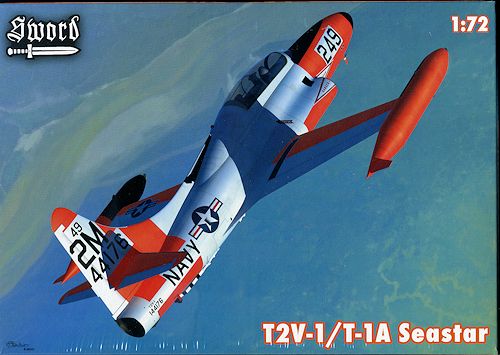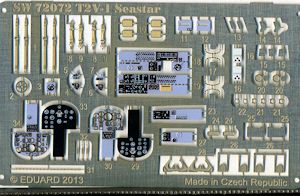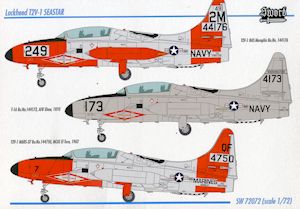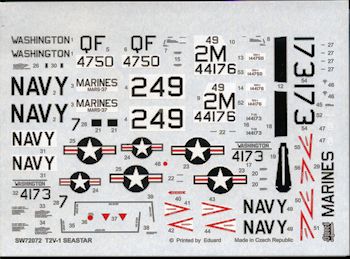
| KIT #: | SW 72072 |
| PRICE: | $32.99 SRP |
| DECALS: | Three options |
| REVIEWER: | Scott Van Aken |
| NOTES: | Short run kit with photo etch and resin parts |

| HISTORY |
Starting in 1949, the U.S. Navy used the Lockheed T-33 for land-based jet aircraft training. The T-33 was a derivative of the Lockheed P-80 fighter and was first named TO-2, then TV-2 in Navy service. However, the TV-2 was not suitable for operation from aircraft carriers. The persisting need for a carrier-compatible trainer led to a further, more advanced design development of the P-80/T-33 family, which came into being with the Lockheed designation L-245 and US Navy designation T2V. Lockheed's demonstrator L-245 first flew on 16 December 1953 and production deliveries to the US Navy began in 1956.
Compared to the TV-2, the T2V was almost totally re-engineered for carrier landings and at-sea operations with a redesigned tail, naval standard avionics, a strengthened undercarriage (with catapult fittings) and lower fuselage (with a retractable arrestor hook), and power-operated leading-edge flaps (to increase lift at low speeds) to allow carrier launches and recoveries, and an elevated rear (instructor's) seat for improved instructor vision, among other changes. Unlike other P-80 derivatives, the T2V could withstand the shock of landing on a pitching carrier deck and had a much higher ability to withstand sea water-related aircraft wear from higher humidity and salt exposure.
The only version of the T2V was initially designated T2V-1 when it entered service, but was redesignated T-1A SeaStar under the 1962 United States Tri-Service aircraft designation system, a name under which it would spend the majority of its career.
The T-1A was replaced by the T-2 Buckeye but remained in service into the 1970s.
One T-1A is currently (2011) airworthy, based at Phoenix-Mesa Gateway Airport (former Williams Air Force Base) in Mesa, Arizona, and being flown for experimental and display purposes. Two examples are preserved on public display in Tucson, Arizona.
| THE KIT |
 Sword
has expanded its F-80/T-33 based kits with this one for the T2V/T-1A Seastar.
There is a growing body of modelers who will be very pleased to see this one. To
my knowledge it is the first time we have seen a 1/72 injected kit of this
aircraft and I know several who have had it on their short list for decades. Now
it is available and I'll bet that it sells out quickly.
Sword
has expanded its F-80/T-33 based kits with this one for the T2V/T-1A Seastar.
There is a growing body of modelers who will be very pleased to see this one. To
my knowledge it is the first time we have seen a 1/72 injected kit of this
aircraft and I know several who have had it on their short list for decades. Now
it is available and I'll bet that it sells out quickly.
Molded on a single grey sprue that has been cut to fit the box along with a clear sprue that has the two piece canopy and brace, the detail on the kit is very good with nicely engraved panel lines that are not too deep nor too lightly done. It is a short run kit so there are things like ejector pin towers on some of the larger pieces and no alignment pins, but I have to tell you that short run in 2013 is a world away from short run in 1993 in terms of the quality of the parts and the engineering.
 The
kit comes with an Eduard color photo etch fret that includes instrument panels,
side consoles, seat harnesses and seat handles along with some exterior bits
like antennas, gear hold down rings, gear door links and the like. The two
cockpits are separate with the front cockpit incorporating the nose gear well.
The two bang seats are resin to ensure good detail. A full tailpipe is provided.
One will need nose weight, but the instructions do not tell how much.
The
kit comes with an Eduard color photo etch fret that includes instrument panels,
side consoles, seat harnesses and seat handles along with some exterior bits
like antennas, gear hold down rings, gear door links and the like. The two
cockpits are separate with the front cockpit incorporating the nose gear well.
The two bang seats are resin to ensure good detail. A full tailpipe is provided.
One will need nose weight, but the instructions do not tell how much.
Though based on the T-33, only the wings, tailplanes and tip tanks are parts that would be recognizable. The T2V has beefier main gear and a different design of nose landing gear. Since it is carrier capable, there is a tailhook as well. The kit's speed brakes are molded closed as are the inner gear doors as they were normally closed except for cycling and maintenance.
 Instructions
are well done and provide generic color information. A full stencil placement
guide is also provided. There are three markings options. The first is the box
art plane from VT-109 at NAS Memphis in 1962 it is white and what the
instructions call signal red. This is not totally accurate as the color was
Instructions
are well done and provide generic color information. A full stencil placement
guide is also provided. There are three markings options. The first is the box
art plane from VT-109 at NAS Memphis in 1962 it is white and what the
instructions call signal red. This is not totally accurate as the color was
 probably
Fluorescent Red/Orange or International Orange. A google will get you images of
both, but be sure you are looking at a period photo as many references are
museum planes and those are almost always painted in International Orange as the
fluorescents fade, even indoors. The second option is from NAF Washington in
1970 and is light gull grey overall. Again, a google search will turn up several
other planes in this easy to paint scheme.The third is from MARS-37 at El Toro,
also in 1962. The decal sheet is printed by Eduard and will be nice
and thin. Some of the markings that go over the red/orange bits have a white
background, but I'll bet there will still be color bleedthrough as intense
colors require totally opaque whites to fully block them.
probably
Fluorescent Red/Orange or International Orange. A google will get you images of
both, but be sure you are looking at a period photo as many references are
museum planes and those are almost always painted in International Orange as the
fluorescents fade, even indoors. The second option is from NAF Washington in
1970 and is light gull grey overall. Again, a google search will turn up several
other planes in this easy to paint scheme.The third is from MARS-37 at El Toro,
also in 1962. The decal sheet is printed by Eduard and will be nice
and thin. Some of the markings that go over the red/orange bits have a white
background, but I'll bet there will still be color bleedthrough as intense
colors require totally opaque whites to fully block them.
| CONCLUSIONS |
I know I have been waiting for this one for a long time and am quite pleased that it is now available. If you have an interest in the F-80/T-33 family or like USN training types, you cannot let this one get away.
| REFERENCES |
http://en.wikipedia.org/wiki/T2V_SeaStar
May 2013
Thanks to Squadron Products for the preview kit. You can find this one at your favorite hobby shop.
If you would like your product reviewed fairly and fairly quickly, please contact the editor or see other details in the Note to Contributors.